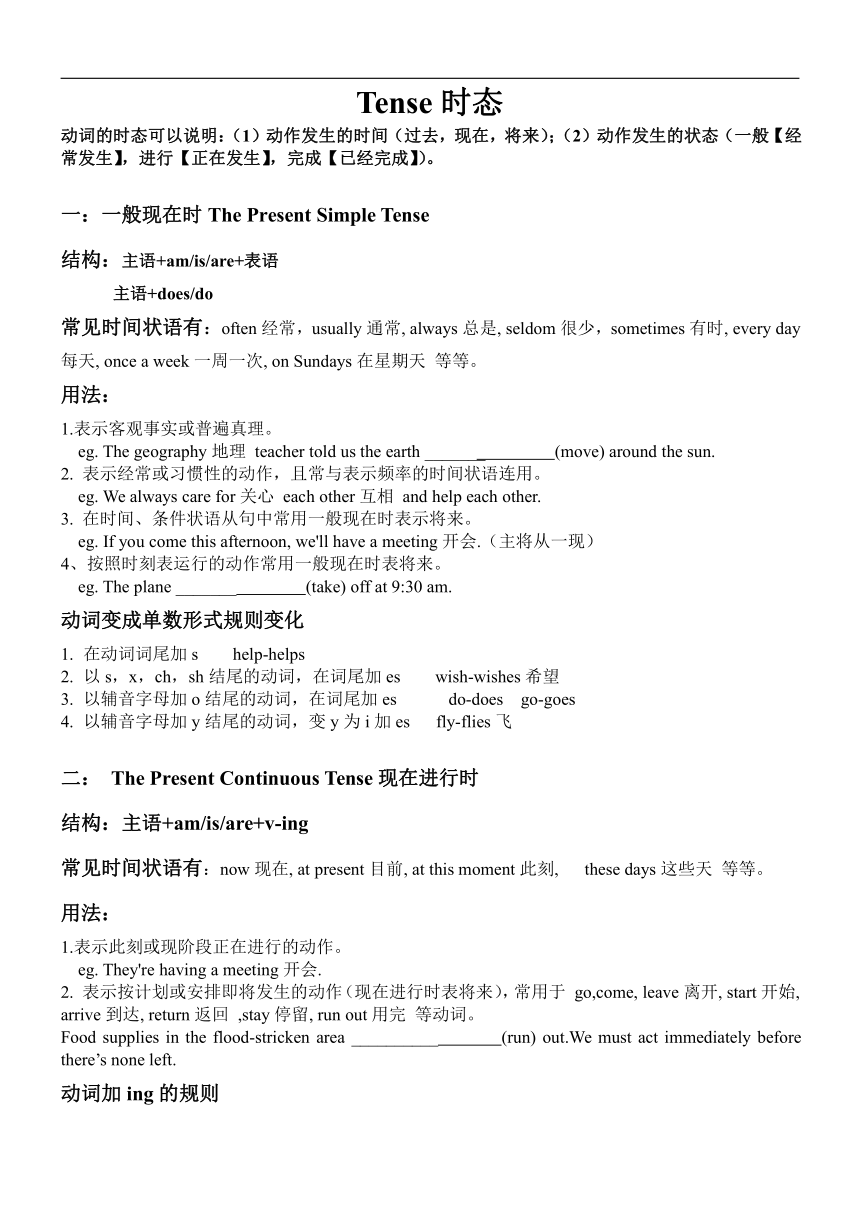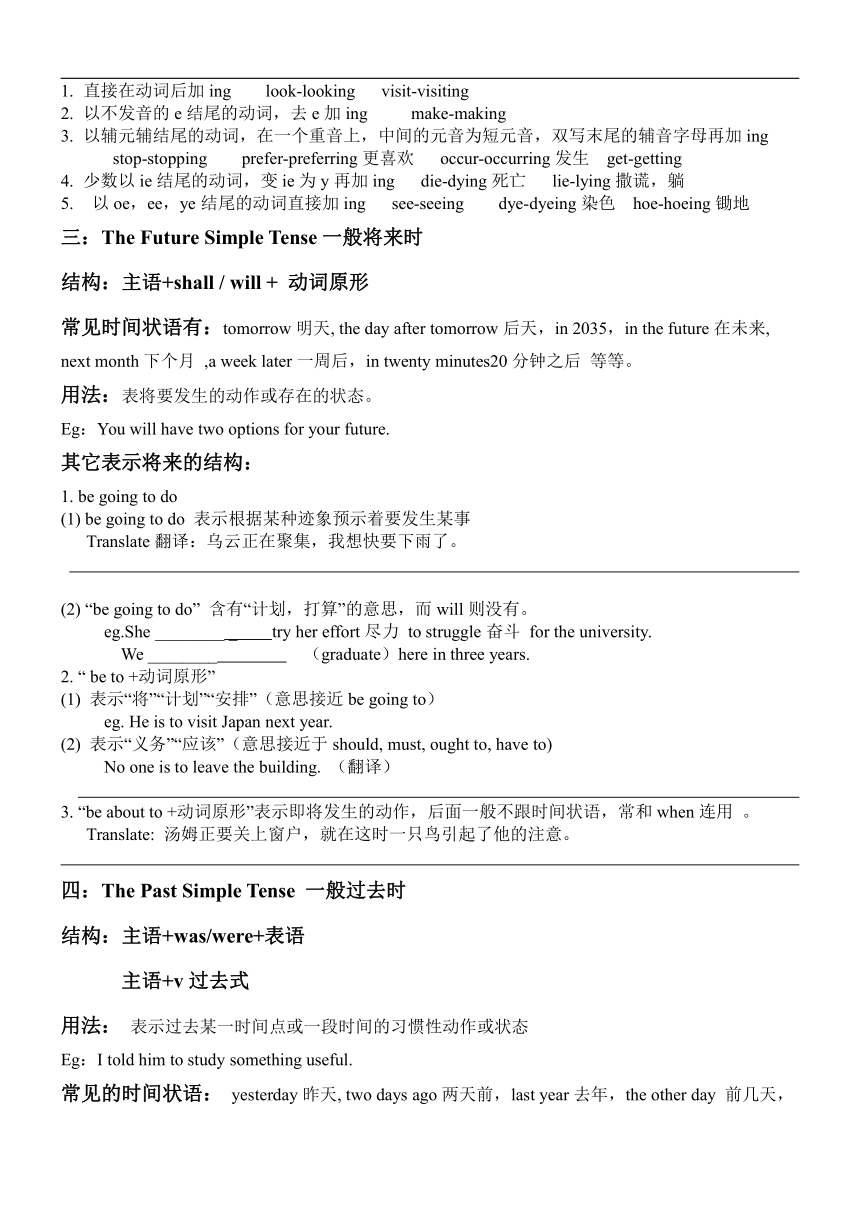外研版(2019)必修第一册Unit 3 Family Matters Using language Tense 导学案(无答案)
文档属性
| 名称 | 外研版(2019)必修第一册Unit 3 Family Matters Using language Tense 导学案(无答案) |  | |
| 格式 | docx | ||
| 文件大小 | 23.3KB | ||
| 资源类型 | 教案 | ||
| 版本资源 | 外研版(2019) | ||
| 科目 | 英语 | ||
| 更新时间 | 2024-03-07 15:08:29 | ||
图片预览


文档简介
Tense时态
动词的时态可以说明:(1)动作发生的时间(过去,现在,将来);(2)动作发生的状态(一般【经常发生】,进行【正在发生】,完成【已经完成】)。
一:一般现在时The Present Simple Tense
结构:主语+am/is/are+表语
主语+does/do
常见时间状语有:often经常,usually通常, always总是, seldom很少,sometimes有时, every day每天, once a week一周一次, on Sundays在星期天 等等。
用法:
1.表示客观事实或普遍真理。
eg. The geography地理 teacher told us the earth _______ (move) around the sun.
2. 表示经常或习惯性的动作,且常与表示频率的时间状语连用。
eg. We always care for关心 each other互相 and help each other.
3. 在时间、条件状语从句中常用一般现在时表示将来。
eg. If you come this afternoon, we'll have a meeting开会.(主将从一现)
4、按照时刻表运行的动作常用一般现在时表将来。
eg. The plane _______ (take) off at 9:30 am.
动词变成单数形式规则变化
在动词词尾加s help-helps
以s,x,ch,sh结尾的动词,在词尾加es wish-wishes希望
以辅音字母加o结尾的动词,在词尾加es do-does go-goes
以辅音字母加y结尾的动词,变y为i加es fly-flies飞
二: The Present Continuous Tense现在进行时
结构:主语+am/is/are+v-ing
常见时间状语有:now现在, at present目前, at this moment此刻, these days这些天 等等。
用法:
1.表示此刻或现阶段正在进行的动作。
eg. They're having a meeting开会.
2. 表示按计划或安排即将发生的动作(现在进行时表将来),常用于 go,come, leave离开, start开始, arrive到达, return返回 ,stay停留, run out用完 等动词。
Food supplies in the flood-stricken area __________ (run) out.We must act immediately before there’s none left.
动词加ing的规则
直接在动词后加ing look-looking visit-visiting
以不发音的e结尾的动词,去e加ing make-making
以辅元辅结尾的动词,在一个重音上,中间的元音为短元音,双写末尾的辅音字母再加ing
stop-stopping prefer-preferring更喜欢 occur-occurring发生 get-getting
少数以ie结尾的动词,变ie为y再加ing die-dying死亡 lie-lying撒谎,躺
以oe,ee,ye结尾的动词直接加ing see-seeing dye-dyeing染色 hoe-hoeing锄地
三:The Future Simple Tense一般将来时
结构:主语+shall / will + 动词原形
常见时间状语有:tomorrow明天, the day after tomorrow后天,in 2035,in the future在未来,
next month下个月 ,a week later一周后,in twenty minutes20分钟之后 等等。
用法:表将要发生的动作或存在的状态。
Eg:You will have two options for your future.
其它表示将来的结构:
1. be going to do
(1) be going to do 表示根据某种迹象预示着要发生某事
Translate翻译:乌云正在聚集,我想快要下雨了。
(2) “be going to do” 含有“计划,打算”的意思,而will则没有。
eg.She ________ _ try her effort尽力 to struggle奋斗 for the university.
We ________ (graduate)here in three years.
2. “ be to +动词原形”
(1) 表示“将”“计划”“安排”(意思接近be going to)
eg. He is to visit Japan next year.
(2) 表示“义务”“应该”(意思接近于should, must, ought to, have to)
No one is to leave the building. (翻译)
3. “be about to +动词原形”表示即将发生的动作,后面一般不跟时间状语,常和when连用 。
Translate: 汤姆正要关上窗户,就在这时一只鸟引起了他的注意。
四:The Past Simple Tense 一般过去时
结构:主语+was/were+表语
主语+v过去式
用法: 表示过去某一时间点或一段时间的习惯性动作或状态
Eg:I told him to study something useful.
常见的时间状语: yesterday昨天, two days ago两天前,last year去年,the other day 前几天,once upon a time从前 ,just now 刚才,in the old days在过去,in the past在过去,two weeks ago两周前,in 1898,an hour ago一个小时前 等等.
规则动词的过去式和过去分词变化规则
一般在动词后加ed depend-depended-depended依赖,取决于 visit-visited-visited拜访,参观
以不发音的e结尾的动词,直接加d like-liked-liked喜欢
以辅音字母+y结尾的动词,变y为i加ed rely-relied-relied依靠 study-studied-studied
以辅元辅结尾的动词,在一个重音上,中间的元音为短元音,双写末尾的辅音字母再加ed
stop-stopped-stopped permit-permitted-permitted允许
不规则动词的过去式和过去分词变化规则参考发的不规则动词表
在英式英语中,travel的过去式和过去分词为travelled,travelled。而在美式英语中,travel的过去式和过去分词为traveled,traveled。类似的还有quarrel吵架,model模拟,dial拨号,signal示意。
五:The Present Perfect Tense 现在完成时
结构:主语+have/has+v过去分词
用法:
1.表示到现在为止已发生或完成的动作,强调对现在的影响。
eg. I __________ (see) the film already.
2. 表示从过去某一时刻开始一直持续到现在的动作或状态,有可能继续持续下去,常与“since+时间点”自从、“for +时间段”持续多久, before之前, so far, up to now,until/till now到目前为止,in the last/past few years在过去几年里, recently最近,over these years这些年,ever曾经等时间状语连用。
eg. She ___________ a dancer for ten years. 她成为舞者已经十年了
I have learned English six years.
3.用于现在完成时的句型
(1)It is (has been)+ 一段时间+since从句 自从...以来,多久了
(2)This (That/It) is the +序数词+ time that 从句(现在完成时)这是某人第几次做某事
(3)This (That/It) is the+adj最高级+名词+that从句(现在完成时) 这是最........
eg. It is the first time that I __________ (visit) the city.
Translate:这是我读过的最有价值的书。
对比一般过去时与现在完成时
现在完成时强调的是该完成的动作或状态对现在的影响,而一般过去时强调的是过去发生了某一动作或有某种状态这样一个事实,其结果不影响到现在。现在完成时不能与过去时的时间状语连用。
I have had lunch.
I had lunch at 12 o’clock.
句子背诵:
It looks like a horrible monster!它看起来像可怕的怪兽
Mummy pig is reading her book.猪妈妈正在看书
Someone did trip over and hurt themselves.确实有人绊到受伤了
Daddy, George! You have stopped tidying up!爸爸,乔治!你们怎么不整理了啊!
We are going to win!我们要赢啦!
以what和how开头的感叹句?
What +a/an +形容词 +名词单数 +(主语+谓语)
例句What an interesting story it is!
What +形容词 +不可数名词/名词复数 +(主语+谓语)
例句 What fine weather it is today!
例句 What good teachers they are!
How + 形容词/副词 +(主语 + 谓语)
例句 How smart she is!
例句 How fast he runs!
How +形容词 +a/an +名词单数 +(主语+谓语)
例句How beautiful a picture it is!
How +主语 + 谓语
例句How times flies!
句子翻译
How true these words were!这话说的太对啦!
How crazy and creative a language English is!英语是一门多么疯狂且有创造性的语言啊!
What a negative word it is!多么消极的一个单词啊!
What confusing information she gave!她给的信息真令人困惑啊!
How I miss you!我真想念你啊!
动词的时态可以说明:(1)动作发生的时间(过去,现在,将来);(2)动作发生的状态(一般【经常发生】,进行【正在发生】,完成【已经完成】)。
一:一般现在时The Present Simple Tense
结构:主语+am/is/are+表语
主语+does/do
常见时间状语有:often经常,usually通常, always总是, seldom很少,sometimes有时, every day每天, once a week一周一次, on Sundays在星期天 等等。
用法:
1.表示客观事实或普遍真理。
eg. The geography地理 teacher told us the earth _______ (move) around the sun.
2. 表示经常或习惯性的动作,且常与表示频率的时间状语连用。
eg. We always care for关心 each other互相 and help each other.
3. 在时间、条件状语从句中常用一般现在时表示将来。
eg. If you come this afternoon, we'll have a meeting开会.(主将从一现)
4、按照时刻表运行的动作常用一般现在时表将来。
eg. The plane _______ (take) off at 9:30 am.
动词变成单数形式规则变化
在动词词尾加s help-helps
以s,x,ch,sh结尾的动词,在词尾加es wish-wishes希望
以辅音字母加o结尾的动词,在词尾加es do-does go-goes
以辅音字母加y结尾的动词,变y为i加es fly-flies飞
二: The Present Continuous Tense现在进行时
结构:主语+am/is/are+v-ing
常见时间状语有:now现在, at present目前, at this moment此刻, these days这些天 等等。
用法:
1.表示此刻或现阶段正在进行的动作。
eg. They're having a meeting开会.
2. 表示按计划或安排即将发生的动作(现在进行时表将来),常用于 go,come, leave离开, start开始, arrive到达, return返回 ,stay停留, run out用完 等动词。
Food supplies in the flood-stricken area __________ (run) out.We must act immediately before there’s none left.
动词加ing的规则
直接在动词后加ing look-looking visit-visiting
以不发音的e结尾的动词,去e加ing make-making
以辅元辅结尾的动词,在一个重音上,中间的元音为短元音,双写末尾的辅音字母再加ing
stop-stopping prefer-preferring更喜欢 occur-occurring发生 get-getting
少数以ie结尾的动词,变ie为y再加ing die-dying死亡 lie-lying撒谎,躺
以oe,ee,ye结尾的动词直接加ing see-seeing dye-dyeing染色 hoe-hoeing锄地
三:The Future Simple Tense一般将来时
结构:主语+shall / will + 动词原形
常见时间状语有:tomorrow明天, the day after tomorrow后天,in 2035,in the future在未来,
next month下个月 ,a week later一周后,in twenty minutes20分钟之后 等等。
用法:表将要发生的动作或存在的状态。
Eg:You will have two options for your future.
其它表示将来的结构:
1. be going to do
(1) be going to do 表示根据某种迹象预示着要发生某事
Translate翻译:乌云正在聚集,我想快要下雨了。
(2) “be going to do” 含有“计划,打算”的意思,而will则没有。
eg.She ________ _ try her effort尽力 to struggle奋斗 for the university.
We ________ (graduate)here in three years.
2. “ be to +动词原形”
(1) 表示“将”“计划”“安排”(意思接近be going to)
eg. He is to visit Japan next year.
(2) 表示“义务”“应该”(意思接近于should, must, ought to, have to)
No one is to leave the building. (翻译)
3. “be about to +动词原形”表示即将发生的动作,后面一般不跟时间状语,常和when连用 。
Translate: 汤姆正要关上窗户,就在这时一只鸟引起了他的注意。
四:The Past Simple Tense 一般过去时
结构:主语+was/were+表语
主语+v过去式
用法: 表示过去某一时间点或一段时间的习惯性动作或状态
Eg:I told him to study something useful.
常见的时间状语: yesterday昨天, two days ago两天前,last year去年,the other day 前几天,once upon a time从前 ,just now 刚才,in the old days在过去,in the past在过去,two weeks ago两周前,in 1898,an hour ago一个小时前 等等.
规则动词的过去式和过去分词变化规则
一般在动词后加ed depend-depended-depended依赖,取决于 visit-visited-visited拜访,参观
以不发音的e结尾的动词,直接加d like-liked-liked喜欢
以辅音字母+y结尾的动词,变y为i加ed rely-relied-relied依靠 study-studied-studied
以辅元辅结尾的动词,在一个重音上,中间的元音为短元音,双写末尾的辅音字母再加ed
stop-stopped-stopped permit-permitted-permitted允许
不规则动词的过去式和过去分词变化规则参考发的不规则动词表
在英式英语中,travel的过去式和过去分词为travelled,travelled。而在美式英语中,travel的过去式和过去分词为traveled,traveled。类似的还有quarrel吵架,model模拟,dial拨号,signal示意。
五:The Present Perfect Tense 现在完成时
结构:主语+have/has+v过去分词
用法:
1.表示到现在为止已发生或完成的动作,强调对现在的影响。
eg. I __________ (see) the film already.
2. 表示从过去某一时刻开始一直持续到现在的动作或状态,有可能继续持续下去,常与“since+时间点”自从、“for +时间段”持续多久, before之前, so far, up to now,until/till now到目前为止,in the last/past few years在过去几年里, recently最近,over these years这些年,ever曾经等时间状语连用。
eg. She ___________ a dancer for ten years. 她成为舞者已经十年了
I have learned English six years.
3.用于现在完成时的句型
(1)It is (has been)+ 一段时间+since从句 自从...以来,多久了
(2)This (That/It) is the +序数词+ time that 从句(现在完成时)这是某人第几次做某事
(3)This (That/It) is the+adj最高级+名词+that从句(现在完成时) 这是最........
eg. It is the first time that I __________ (visit) the city.
Translate:这是我读过的最有价值的书。
对比一般过去时与现在完成时
现在完成时强调的是该完成的动作或状态对现在的影响,而一般过去时强调的是过去发生了某一动作或有某种状态这样一个事实,其结果不影响到现在。现在完成时不能与过去时的时间状语连用。
I have had lunch.
I had lunch at 12 o’clock.
句子背诵:
It looks like a horrible monster!它看起来像可怕的怪兽
Mummy pig is reading her book.猪妈妈正在看书
Someone did trip over and hurt themselves.确实有人绊到受伤了
Daddy, George! You have stopped tidying up!爸爸,乔治!你们怎么不整理了啊!
We are going to win!我们要赢啦!
以what和how开头的感叹句?
What +a/an +形容词 +名词单数 +(主语+谓语)
例句What an interesting story it is!
What +形容词 +不可数名词/名词复数 +(主语+谓语)
例句 What fine weather it is today!
例句 What good teachers they are!
How + 形容词/副词 +(主语 + 谓语)
例句 How smart she is!
例句 How fast he runs!
How +形容词 +a/an +名词单数 +(主语+谓语)
例句How beautiful a picture it is!
How +主语 + 谓语
例句How times flies!
句子翻译
How true these words were!这话说的太对啦!
How crazy and creative a language English is!英语是一门多么疯狂且有创造性的语言啊!
What a negative word it is!多么消极的一个单词啊!
What confusing information she gave!她给的信息真令人困惑啊!
How I miss you!我真想念你啊!
